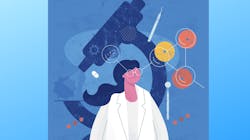Why you should consider becoming a biological dental hygienist
Dental hygienists are often underutilized members of the health team. It’s time to expand beyond our traditional job skills of removing calculus and polishing teeth. Tooth decay is at epidemic levels.1 Periodontal disease is directly connected to cardiovascular disease2 and dementia.3 With the incidence of dementia predicted to triple by 2050,4 our profession needs to rise up and join the game. Hygienists have the training and skills to take our rightful place as key members of the health-care team, and we can help our patients heal not only their mouths but also their bodies.
My biological journey
I’m a biological dental hygienist. I love being a dental hygienist, but this wasn’t always the case. My first year in hygiene I saw 10 patients a day and 50 patients a week. I was constantly behind schedule and very frustrated not to be able to spend time being the healer and health-care professional I wanted to be. I lasted exactly one year before I put down my scaler and resolved to leave the profession. I transitioned into sales, and one day I walked into a dental office that used a phase contrast microscope. When they described how they used it, I asked to work with them. It was a game-changer for me and it was love at first slide.
More reading by or about Barbara Tritz
"Hygiene is so much more than scraping teeth. We are lifesavers."
Want a perfect kiss? Start with oral health
For far too long I had concentrated on plaque and calculus removal, thinking that if I just removed the irritants and pathogens, the body would automatically heal itself. My patients flossed, brushed, and used fluoride exactly as they were taught. Yet tooth decay, bleeding gums, and bone loss persisted. I was missing something important. The microscope changed my treatment, and while it was a start, it wasn’t enough. This sent me on a journey to learn more about the root causes of oral disease.
I first heard the term “biological dental hygiene” five years ago. I had no idea this was a thing.5 Through my biological training, I learned to dig deeper. Our mission, working with a biological dentist, is to look within the body to help patients prevent and heal their dental diseases.
Two associations offer dental hygiene education in this biological philosophy—the International Academy of Biological Dentistry and Medicine (IABDM)6 and the International Academy of Oral Medicine and Toxicology (IAOMT).7 Both programs are online and self-paced modules and CE credits are given when a course is completed. They offer a great introduction regarding what’s involved in being a biological hygienist.
Being biological
Even with my new perspective.8 I still perform many of the traditional skills we learned in school, such as scaling, polishing, and oral hygiene instructions. The difference is, my tools have expanded to include air polishing and guided biofilm therapy with ozone water, ozone insufflation9 (ozone gas into the sulcus), oral irrigation with medicaments, platelet-rich fibrin10 therapy, laser therapy, more frequent recare, and of course, the microscope and salivary diagnostics.
My home-care recommendations are customized to address all issues, and the goal is a healthy microbiome. With my additional training in orofacial myofunctional therapy, I also discuss airway, mouth breathing, proper facial growth, and sleep issues. Patients should learn how to properly chew and use their noses to breathe. Nutrition11 is also a big part of oral hygiene prevention programs and education. Unless we discuss food and address gut absorption, patients won’t have the necessary building blocks for health. The goal is to help them learn about and use the most health-driven tools and techniques possible.
Test, teach, treat, repeat
My mantra is “test, teach, treat, repeat.” I use the microscope on every patient. They expect and ask for it and they understand its value. Seeing the tangible evidence of all their hard work is its own reward. The slide transition from bad bacteria such as spirochetes or amoebas12 to a healthy microbiome is the ultimate motivator and provides the push for them to keep moving forward and healing.
In addition to chairside microscopy, we should consider including salivary diagnostics because caries may have a fungal component,13 and periodontal diseases often have a viral origin.14[14] While we’re able to see yeast on the scope, viruses are too small to see. An expanded toolbox enhances our diagnostic abilities. Caries swabs, iTero scans, CT scans, pH test strips, nitric oxide testing, referral for blood work, and a sleep study are vital tools that help guide our therapies. Knowing what’s happening and why there’s disease and inflammation helps direct our therapies.
The deeper dive
With more thorough testing, I found that not every case of bleeding gums or decay results from dysbiotic bacterial biofilm or requires further scaling. Looking beyond the teeth and gums to other contributors of dental problems, such as hormone imbalance, vitamin or mineral deficiencies, nutrition, gut dysbiosis, mouth breathing, sleep-disordered breathing, silent acid reflux, allergies, fluoride toxicity, electrical imbalances, emotions, stress, heavy metal reactions, malocclusion, or systemic health issues, gives us real answers. Healing involves the entire body, not just the removal of symptoms.
Keystone health-care provider
The keystone is the central stone in an arch that locks the entire structure together and gives it strength and support. Dental hygienists are the keystone provider. We have a great overview of how the entire body fits together with the symptoms that we see in the mouth. Oral pathogens travel across the blood-brain barrier15 and contribute to cognitive decline.16 Heart attacks17 can be triggered by dental procedures for up to 30 days18 after appointments. Inflammation and infections are rampant in the mouth and can spread easily throughout the body. Yet, the body is capable of healing itself if given the right tools. This reinforces the importance of what we do.
We can guide and orchestrate the healing process between specialists, such as an ENT, allergist, myofunctional therapist, airway dentist, and other providers, while coaching and encouraging patients. It’s time to invite these specialists into our dental world and show them we do more than scrape teeth and teach flossing. We gain valuable information through our observations and testing. Show them what lurks under the gumline, and explain how patients inhale, swallow, and introduce pathogens into the bloodstream and cause bacteremia15 within 60 seconds of brushing, flossing, or dental care. Collaboration cures if we all work together.
The case for collaboration
Here’s an example of the wonders of collaboration. Mrs. C. worked diligently on her home-care; however, her gums were not healing. We did therapy, changed home-care products, and added tools and techniques, but the inflammation remained. Because of the tenderness and friability of the tissue, her oral hygiene was difficult.
After viewing the microscope slide and seeing no obvious periodontal pathogens, I encouraged her to see her primary care doctor for bloodwork. Luckily, she made that appointment. As it turned out, she was in the early stage of leukemia. The microscope showed us the inflammation we were trying to address was not bacterial in origin, and something felt wrong. Her doctor was surprised that a dental hygienist referred her for a physical. The microscope saved her life.
Biological dental hygiene rises to the challenge
The dental hygiene profession can help turn the tide of chronic conditions, such as cardiovascular disease and dementia, by changing our focus from traditional scaling and polishing to real, true, systemic healing. Look for the “whys” of a disease and step outside the box for answers. Address the root causes of dental disease by learning more about oral-systemic connections, using diagnostic tests, and collaborating with other providers. We must no longer accept a “little bleeding” or “just one cavity.”
We can eliminate dental disease and be the healers we’re truly meant to be. This is our moment. We are life-changers and lifesavers. Biological dental hygienists up the game. Come join us.
Editor's note: This article appeared in the April 2023 print edition of RDH magazine. Dental hygienists in North America are eligible for a complimentary print subscription. Sign up here.
References
1. The state of little teeth. American Academy of Pediatric Dentistry. 2022. Accessed December 23, 2022. https://www.aapd.org/assets/1/7/State_of_Little_Teeth_Final.pdf
2. The oral-systemic connection: how bacteria in your mouth can harm your heart. BaleDodeen Method. 2022. Accessed December 23, 2022. https://baledoneen.com/blog/the-oral-systemic-connection-how-bacteria-in-your-mouth-can-harm-your-heart/
3. Beydoun MA, Beydoun HA, Hossain S, El-Hajj ZW, Weiss J, Zonderman AB. Clinical and bacterial markers of periodontitis and their association with incident all-cause and Alzheimer's disease dementia in a large national survey. J Alzheimers Dis. 2020;75(1):157-172. doi:10.3233/JAD-200064. PMID: 32280099
4. Global dementia cases forecasted to triple by 2050. Alzheimer’s Association International Conference. July 27, 2021. Accessed December 23, 2022. https://aaic.alz.org/releases_2021/global-prevalence.asp
5. Biological dental hygiene accreditation. International Academy of Oral Medicine and Toxicology. 2022. Accessed December 23, 2022. https://iaomt.org/for-members/dental-hygiene-accreditation/
6. Global network of biological dentists. International Academy of Biological Dentistry & Medicine . https://iabdm.org/
7. The International Academy of Oral Medicine and Toxicology. https://iaomt.org/
8. Tritz B. Meet the world of biological dentistry. Queen of Dental Hygiene. August 7, 2017. Accessed December 23, 2022. http://queenofdentalhygiene.net/2017/08/meet-the-world-of-biological-dentistry
9. Ramirez-Peña AM, Sanchez-Perez A, Campos-Aranda M, Hidalgo-Tallon FJ. Ozone in patients with periodontitis: a clinical and microbiological study. J Clin Med. 2022;11;(10):2946. doi:10.3390/jcm11102946
10. Sharma R, Sharma P, Sharma SD, Chhabra N, Gupta A, Shukla D. Platelet-rich fibrin as an aid to soft- and hard-tissue healing. J Maxillofac Oral Surg. 2021;20(3):496-501. doi:10.1007/s12663-019-01317-7
11. Tritz B. Tooth decay. Queen of Dental Hygiene. July 6, 2021. Accessed December 23, 2022. http://queenofdentalhygiene.net/2021/07/tooth-decay-care/
12. Common oral parasite linked to severe inflammation and tissue destruction of periodontitis. Nutrition Review. April 15, 2020. Accessed December 31, 2022. https://nutritionreview.org/2020/04/common-oral-parasite-linked-to-severe-inflammation-and-tissue-destruction-of-periodontitis/
13. Lund A. Bacterium, fungus may lead to early childhood caries. J Am Dent Assoc. 2014;145(5):426-427. doi:10.1016/s0002-8177(14)60033-7
14. Sedghi LM, Bacino M, Kapila YL. Periodontal disease: the good, the bad, and the unknown. Front Cell Infect Microbiol. 2021;7(11):766944. doi:10.3389/fcimb.2021.766944
15. Allen HB, Joshi SG. Alzheimer’s disease: a novel hypothesis integrating spirochetes, biofilm, and the immune system. Research Gate. https://www.researchgate.net/profile/Herbert-Allen-2/publication/294089000_Alzheimer's_Disease_A_Novel_Hypothesis_Integrating_Spirochetes_Biofilm_and_the_Immune_System/links/56be035d08aee5caccf2eab6/Alzheimers-Disease-A-Novel-Hypothesis-Integrating-Spirochetes-Biofilm-and-the-Immune-System.pdf
16. Good oral health may help protect against Alzheimer’s. Harvard Health. September 1, 2019. Accessed December 28, 2022. https://www.health.harvard.edu/mind-and-mood/good-oral-health-may-help-protect-against-alzheimers
17. Nordqvist C. Dental surgery linked to short term stroke and heart attack risk. Medical News Today. October 19, 2010. Accessed December 28, 2022. https://www.medicalnewstoday.com/articles/205129#1
18. Minassian C, D’Aluto F, Hingorani AD, Smeeth L. Invasive dental treatment and risk for vascular events: a self-controlled case series. October 19, 2010;153(8):499-506. Ann Intern Med. https://www.acpjournals.org/doi/10.7326/0003-4819-153-8-201010190-00006
About the Author

Barbara Tritz, MSB, BSDATE, BRDH
Barbara is a practicing biological dental hygienist at Green City Dental in Edmonds, Washington. She is the owner of Washington Oral Wellness in Kirkland, Washington, where she practices orofacial myofunctional therapy. She completed her accreditation in biological dental hygiene through the International Academy of Oral Medicine and Toxicology, and is laser certified through the Academy of Laser Dentistry. In 2019 Barbara received the HuFriedy-American Dental Hygienist Association Master Clinician Award. Barbara can be contacted at [email protected].
